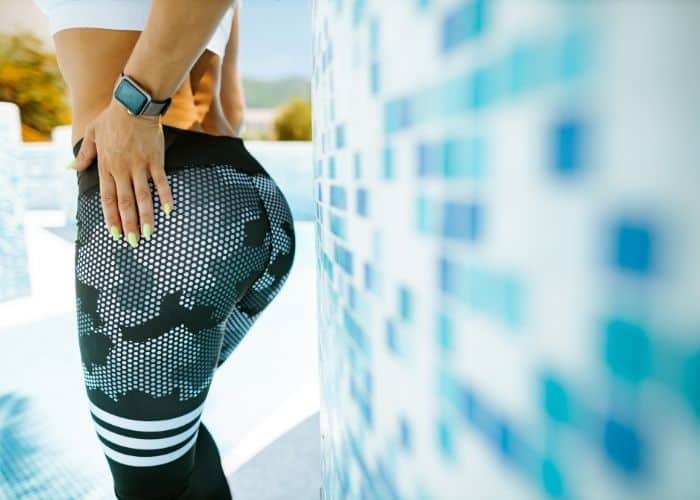
When I was in college, I worked in a campus dining restaurant. It was an Italian place and I remember we had this new dish we added to the menu.
I’ll never forget the question a customer asked me…
“Will this make my butt bigger?“
I had literally no clue. I was under 21 and the dish didn’t come with a lecture to the staff on where fat gained from consumption deposited.
Plus, I didn’t know if she was asking if the dish was going to make her fat in the behind or add thick curves to her figure.
(In case you’re invested in the story, I did NOT offend her.)
Long story short, I was inspired to write a post on the subject.
If you’re looking for foods that go straight to your bum, there are 27 in this article covering different food groups, including meat, vegetables, grains, nuts and seeds, dairy, and vegan. The key to gaining fat in your butt is balancing your protein, carbohydrate, and fat intake in a healthy way.
These 27 foods will make your butt bigger (if you want a thicker figure):
- Salmon
- Tuna Fish
- Sardines
- Anchovies
- Flax Seeds
- Chia Seeds
- Pumpkin Seeds
- Cashews
- Almonds
- Brown Rice
- Quinoa
- Whole Wheat Pasta
- Avocado
- Black Beans
- Spinach
- Kale
- Chickpeas
- Milk
- Greek Yogurt
- Cottage Cheese
- Protein Shakes
- Chicken Breast
- Eggs
- Turkey Breast
- Ground Pork
- Tofu
- Soy Milk
In case you count calories, which I absolutely recommend when you want to lose weight (as weight loss is nothing more than a caloric deficit), I’ve also provided standard nutrition information for each food.
You may come across other articles on the subject, but I doubt any others show you the macronutrients you’re consuming in the process of getting a juicy booty.
Let’s dive a little deeper!
Table of Contents
What Foods Make Your Butt Bigger?
Essentially, a rounded diet will help make your butt bigger.
By that, I mean food that contains carbs, protein, and fats, but also food that comes in various food groups.
The foods in this post are broken down into:
- Fish
- Nuts and seeds
- Grains
- Vegetables
- Dairy
- Meat
- Vegan
In addition to the foods overview, I’ll also discuss:
- Why you should eat carbs
- Why you should eat protein
- Why you should eat fats
Having a list of what foods to eat is just part of the equation.
Without knowing how those macronutrients (fat, carbs, and protein) interact in your diet, you’ll be like a blind squirrel chasing a nut.
While you may succeed in getting a juicy booty by accident, you’ll succeed more if you come in with a dietary plan.
If you consume too much fat, then you’ll just end up with a fat bottom.
What you want is a curvaceous behind that shows off your dress or high-waisted jeans.
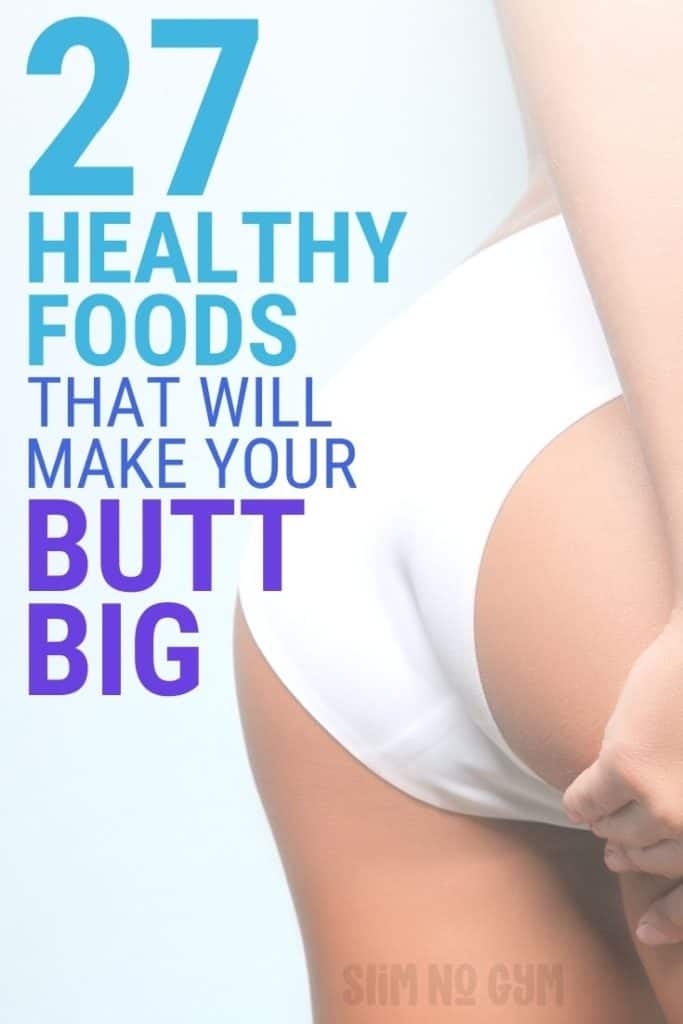
Why You Should Eat Carbs
Let’s bust a myth off the bat.
CARBOHYDRATES ARE NOT THE ENEMY.
I’m tired of people claiming gluten-free because they they think it’s a health trend that they need to ride or die by.
Carbohydrates are needed in a balanced diet and contrary to popular opinion, they don’t make your stomach fat.
You get abdominal fat by consuming a caloric surplus. That means you’re eating more food than your body is burning off.
I remember when I was in school my gym teacher used to tell me that to burn off one M&M, you had to walk the entire length of a football field.
Whether it’s your body’s metabolism burning calories or exercise, you need to keep track of what you’re eating and what you’re burning.
Carbs give us one primary part of the thicker booty equation: glycogen.
Here’s the process when you eat carbs:
- You eat carbs
- Your body converts them to a sugar called glucose (glucose is what fuels our cells)
- The excess glucose is stored in the liver and muscles
The stored form of connected glucose molecules is called glycogen, according to KidsHealth.org.
When your body needs a quick boost of energy, the glycogen gets broken down to release glucose into the bloodstream.
Why is this important?
If you don’t consume carbohydrates and produce glycogen, then your body will be forced to break down muscles to get energy (if there isn’t any fat left).
And an atrophied physique is not chic.
What’s important is that you consume the right carbs so you get all the benefits from healthy carbs without them also coming with tons of fat and processed sugar (aka processed foods).
Why You Should Eat Protein
If you’re a vegetarian as I am, then protein is a little hard to come by. More so if you’re vegan.
But, that doesn’t mean that you should avoid it altogether just because it’s not readily available.
The building blocks of proteins are called amino acids.
There are two types of amino acids:
- Essential amino acids
- Non-essential amino acids
Essential and Non-Essential Amino Acids
| Essential Amino Acids | Non-Essential Amino Acids |
|---|---|
| Histidine | Alanine |
| Isoleucine | Arginine |
| Leucine | Asparagine |
| Lysine | Aspartate |
| Methionine | Cystine |
| Phenylalanine | Glutamic |
| Threonine | Glycine |
| Tryptophan | Ornithine |
| Valine | Proline |
| Serine | |
| Tyrosine |
Non-essential amino acids are what your body can synthesize itself. The essential amino acids have to be supplemented by your diet.
I won’t bore you with the actual science that goes into it, but what I will say is that you’re on the hook for the essential amino acids.
They need to come from your diet (hence why you need to consume protein).
Weight-Friendly Tip
Research published in the Applied Physiology, Nutrition, and Metabolism Journal states that “higher” protein diets are shown to be effective in promoting weight reduction, particularly fat loss.Most animal products are a complete protein source, meaning that they contain all the essential amino acids.
Plant-based products are a little trickier.
There are three plants that are a complete source of protein:
- Soy
- Quinoa
- Spirulina (algae that usually comes in powder form)
Aside from them, plant-based foods come as incomplete proteins. When you combine multiple, you get complementary proteins.
An example would be consuming grains with dairy. That will give you all the essential amino acids (protein) your body needs to function.
Since every cell in the human body contains protein, it’s used to repair cells and make new ones. Ditch protein and your body won’t function properly.
Period.
Why You Should Eat Fats
In case you’re unaware, 1 gram of fat equals 9 calories.
That’s more than the rest:
- Protein: 4 calories/gram
- Carbohydrates: 4 calories/gram
- Alcohol (Ethanol): 7 calories/gram
- Fat: 9 calories/gram
That’s why you have to watch your fat consumption.
But, fats are important because certain vitamins are only absorbed by fat.
There are two types of vitamins (from a broad perspective):
- Fat-soluble vitamins (A, D, E, and K)
- Water-soluble vitamins (B and C)
Here’s a full chart breaking that down.
Fat-Soluble and Water-Soluble Vitamins
| Fat-Soluble Vitamins | Water-Soluble Vitamins |
|---|---|
| Vitamin A (Retinol) | Vitamin B1 (Thiamine) |
| Vitamin D | Vitamin B2 (Riboflavin) |
| Vitamin E | Vitamin B3 (Niacin) |
| Vitamin K | Vitamin B5 (Pantothenic Acid) |
| Vitamin B6 (Pyridoxine) | |
| Vitamin B7 (Biotin) | |
| Vitamin B9 (Folate) | |
| Vitamin B12 (Cobalamin) | |
| Vitamin C (Ascorbic Acid) |
Now that you’ve got the vitamins sorted out, here are the functions for the fat-soluble ones:
- Vitamin A: Promotes eye health and good vision
- Vitamin D: Boosts calcium absorption and protects the bones
- Vitamin E: Supports the immune system and maintains healthy skin and eyes
- Vitamin K: Helps blood clot
As you can see, these functions are rather important, so you need to consume fats so these vitamins can be absorbed.
The foods high in fat on this list focus on monounsaturated fats (the healthy fat) and saturated fats when unavoidable, but there are no trans fats to be found.
When you consume the right kinds of fat in the right quantities, you’ll gain fat deposits that aren’t unhealthy. AKA, you’ll get a thicker booty.
You can then shape that more with exercise.
4 Types of Fish That Will Make Your Butt Bigger
Fish are a great source of the healthy fats.
The unsaturated fats in fish are known as Omega-3 fatty acids and are recommended to consume around 1-2x a week.
According to Joyce A. Nettleton, author of the book Omega-3 Fatty Acids and Health, it wasn’t until the 1980s that the media gave sustained publicity to the Omega-3 fatty acids present in seafood and fish oils.
Now, fish oil supplements are quite common. I know my diabetic father takes them on the regular.
Here are four fish high in healthy fats that will make your butt bigger:
- Salmon
- Tuna Fish
- Sardines
- Anchovies
Let’s dive a little deeper! (Pun kind of intended?)
1. Salmon

Salmon, otherwise known as the hideous color of bridesmaid dresses in the ’80s and ’90s, is quite healthy for you.
In the world of fish production, there are two types available:
- Wild
- Farmed
There are some allegations that farmed fish may be contaminated, but farming fish is the only way to create the volume necessary to satisfy the demand.
The nutrition facts below are for farmed Atlantic salmon.
Salmon
| Serving: 4 oz fillet Calories: 236 |
||
|---|---|---|
| % Daily Value | ||
| Total Fat | 15g | 23% |
| Cholesterol | 62mg | 21% |
| Sodium | 67mg | 3% |
| Total Carbohydrates | 0g | 0% |
| Sugars | 0g | |
| Protein | 23g | 46% |
While the fat is high, it’s the right kind of fat.
Research on fatty acids in sports suggests this kind of fat can help reduce inflammation and improve performance for those who are physically active.
The only other thing to note about salmon is that it is high in cholesterol. If you already have high cholesterol, then consider a smaller portion.
But, salmon is a great source of protein and fat, when consumed in the right amounts.
2. Tuna Fish
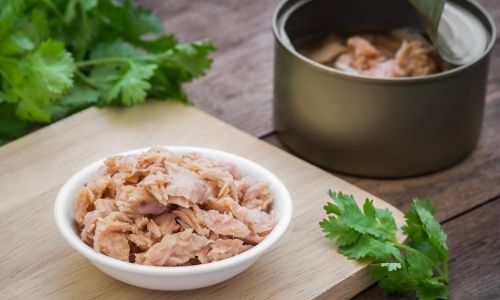
If you’re going to eat tuna fish, do it out of the can.
While tuna steaks are delicious (I made a great Italian recipe in culinary school), it’s much more expensive. Stick with the can.
When purchasing the can, make sure you look for Albacore tuna.
Tuna typically comes canned in two ways:
- With water
- With oil
You don’t want the added oil. That’s the wrong kind of fat. Stick with the water kind, but then make sure it’s drained well before using.
Below is the nutrition information for Albacore tuna canned with water, after it’s been drained.
Tuna Fish
| Serving: 3 oz can Calories: 109 |
||
|---|---|---|
| % Daily Value | ||
| Total Fat | 3g | 4% |
| Cholesterol | 36mg | 12% |
| Sodium | 321mg | 13% |
| Total Carbohydrates | 0g | 0% |
| Sugars | 0g | |
| Protein | 20g | 40% |
Tuna doesn’t have as much fat as salmon, but it’s an excellent source of protein.
If you want to consume it raw, eat sushi.
But, make sure you get it from a place that regularly receives fish shipments because days-old “fresh” fish is just nasty.
Tuna does have a considerable amount of sodium, purely because it’s processed. Draining the tuna will remove some of the added salt, but don’t add too much when preparing the fish.
Tuna fish goes great with:
- Whole-grain crackers
- Salads
It might not be your favorite food, but it is healthy.
3. Sardines
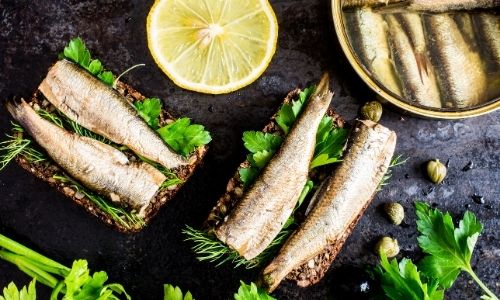
Sardines are one of the few fish you can eat whole, bones and all.
When buying sardines, look for those coming from the Atlantic that have been processed in oil. You’ll then want to drain the oil.
Here’s the nutrition info for sardines prepared that way:
Sardines
| Serving: 1 each Calories: 25 |
||
|---|---|---|
| % Daily Value | ||
| Total Fat | 1g | 2% |
| Cholesterol | 17mg | 6% |
| Sodium | 61mg | 3% |
| Total Carbohydrates | 0g | 0% |
| Sugars | 0g | |
| Protein | 3g | 6% |
What’s important to note about sardines is that you probably won’t eat them straight out of the can.
I wouldn’t.
Be careful about how much oil or fat you add if you’re sautéing them.
According to research published in the Journal of Agricultural and Food Chemistry, oils like lard will increase the saturated fat content much more than neutral vegetable oils like sunflower oil.
No bueno.
But, once you cook them, that research concluded that their cholesterol content decreased.
Sardines are a great choice to get a thicker butt because they’re high in nutrients (like Vitamin B-12 and calcium) but they’re low in calories.
That’s exactly what you want to balance out a diet and meal plan.
4. Anchovies

Anchovies are one of the classic ingredients in pasta puttanesca that really contribute to that classic flavor.
Kind of like how lemons are the salt of baking and pastry (meaning they help enhance whatever flavors are there), anchovies are the salt of the sea.
They add a complex flavor to fish dishes and sauces in small quantities.
You’ll typically find anchovies canned and packed in oil. That’s perfectly fine. Just make sure you pat them down of excess oil before chopping them up and cooking them.
Here’s the nutrition info for anchovies.
Anchovies
| Serving: 5 each Calories: 42 |
||
|---|---|---|
| % Daily Value | ||
| Total Fat | 2g | 3% |
| Cholesterol | 17mg | 6% |
| Sodium | 734mg | 31% |
| Total Carbohydrates | 0g | 0% |
| Sugars | 0g | |
| Protein | 6g | 12% |
Off the bat, you’ll see that they have a high sodium content. That’s for 5 anchovies, which may be more than you need to cook your dish.
Try not to add extra salt when cooking with anchovies.
But, they are a great healthy source of protein and fats.
Weight-Friendly Tip
The reason why anchovies have such high sodium content is because they’re cured (in salt) for months prior to packaging. But, the mouthwatering umami flavor comes from the glutamate that develops during the curing process. Monosodium glutamate, also known as MSG, is the unhealthy flavoring common in Asian cuisine. Anchovies give you that flavor without the adverse effects, provided you watch your salt intake.The Omega-3 fatty acids in anchovies have even been shown to reduce triglyceride levels in your body, according to research in Current Opinions in Lipidology.
Anchovies work great chopped up and added to sauces, or they can be pureed as a paste to be used gradually over time.
Either way, anchovies are your friend (even if you’d never be caught dead ordering them on a pizza).
5 Nuts and Seeds That Will Give You a Big Bum
You’ve probably heard this before, but a calorie in is not the same as a calorie out. It may also be phrased as a calorie is not a calorie.
The premise is the same: your body processes different kinds of foods differently, but it burns them just the same.
You have to burn approximately 3,500 calories to lose one pound of weight.
Crazy, right? Especially since you’re not supposed to eat more than 2,000 calories per day.
If you treat your body right and provide it with healthy calories, then you won’t be concerned about not feeling full. You’ll end up eating less. And eating less to feel full will help you avoid adding the wrong kind of fat.
Nuts and seeds are healthy calories because of their fiber and unsaturated fat content.
Here are 5 nuts and seeds that will help you get a bigger bum:
- Flax Seeds
- Chia Seeds
- Pumpkin Seeds
- Cashews
- Almonds
Let’s dive a little deeper!
5. Flax Seeds
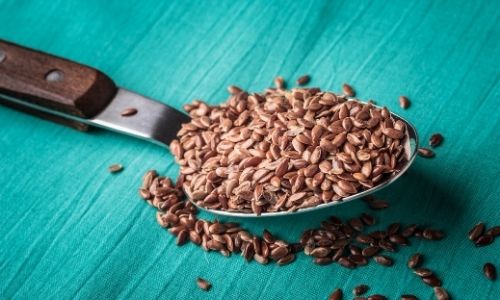
Some people are dubbing flax seeds as the new wonder food, which is surprising considering it’s been around for thousands of years.
Preliminary evidence has shown that flax seeds can help prevent:
- Heart disease
- Cancer
- Stroke
- Diabetes
Not bad for just a seed.
Here’s the nutrition information for whole flax seeds.
Flax Seeds
| Serving: 1/4 cup Calories: 224 |
||
|---|---|---|
| % Daily Value | ||
| Total Fat | 18g | 27% |
| Cholesterol | 17mg | 6% |
| Sodium | 13mg | 1% |
| Total Carbohydrates | 12g | 4% |
| Sugars | 1g | |
| Protein | 8g | 15% |
Not mentioned on that chart is that one serving of flax seeds contains 40% of the daily recommended value for fiber.
Research published in the Journal of the Science of Food and Agriculture suggests that flax seeds are one of the richest sources of a-linoleic acid oil and lignans.
Alpha-linoleic acid has been thought to help reduce the risk for heart disease by helping to maintain a regular heart rhythm and decreasing blood clots.
Weight-Friendly Tip
When consuming a lot of fat, you have to be concerned about heart health. Too much fat can clog your arteries, which can prevent blood flow and circulation. Make sure not to consume fat in excess and stick to unsaturated fats.Flax seeds go great in:
- Salads
- Smoothies
- Spice blends
However you eat them, flax seeds are heart-healthy and provide the right kind of fat to add curves without cellulite.
6. Chia Seeds
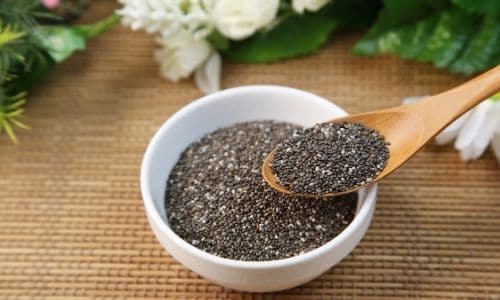
Chia seeds are like the vacuum for your body. While that may sound weird, it’s a great analogy.
You see, chia seeds are quite gelatinous when added to water, so when they’re consumed, the toxins cling to the gel, purifying your body from the inside out.
Not to mention, according to the Harvard University School of Public Health, chia seeds have been shown to:
- Reduce appetite
- Reduce weight
- Lower triglycerides
- Improve blood sugar levels in Type 2 diabetics
Here’s the nutrition info for chia seeds.
Chia Seeds
| Serving: 1 oz Calories: 138 |
||
|---|---|---|
| % Daily Value | ||
| Total Fat | 9g | 13% |
| Cholesterol | 0mg | 0% |
| Sodium | 5mg | 0% |
| Total Carbohydrates | 12g | 4% |
| Sugars | 2g | |
| Protein | 5g | 9% |
One serving of chia seeds also contains 40% of the daily value for fiber and is high in polyunsaturated fat, presented as Omega-3 fatty acids.
Since chia seeds are delicate and break easily when exposed to water, they’re commonly prepared as a liquid food, such as:
- Chia gel (to help thicken smoothies)
- Chia pudding
They can even be used to replace whole eggs in baking.
Chia seeds are multi-faceted, having a wide array of cooking/baking applications and being nutritious.
They can also store for 4-5 years in a dry place unrefrigerated, which means they have a longer shelf life than most of the other foods on this list.
In other words, they’re a no-brainer to include in your diet for a thicker booty.
7. Pumpkin Seeds

Pumpkin seeds, also known as pepitas, are the seeds that come from a pumpkin. Yes, literally.
With all the jack-o-lanterns you made as a child and with your kids, you could’ve saved the gloop from the trash can and turned it into a health food.
Pepitas traditionally come in the following forms:
- Raw
- Sprouted
- Roasted (dry)
Here’s the nutrition info for dry-roasted pumpkin seeds.
Pumpkin Seeds
| Serving: 1/4 cup Calories: 180 |
||
|---|---|---|
| % Daily Value | ||
| Total Fat | 16g | 24% |
| Cholesterol | 0mg | 0% |
| Sodium | 2mg | 0% |
| Total Carbohydrates | 3g | 1% |
| Sugars | 0g | |
| Protein | 10g | 19% |
One serving of pepitas also contains 16% of the daily value of iron, on top of the numerous health benefits they contain.
Dating back to the Oaxacan highlands in Mexico over 7,500 years ago, pumpkin seeds have been known as a folk remedy to help treat:
- High blood pressure
- High blood sugar
- Worm-like parasites
- Kidney stones
- Urinary tract and bladder infections
Research published in the Indonesian Journal of Cancer Chemoprevention says that pumpkin seeds are rich in Vitamin E (fat-soluble vitamin) contents and may also help with anti-aging.
Containing unsaturated fats and doubling as a quality protein source, pumpkin seeds are a great addition to your diet.
8. Cashews
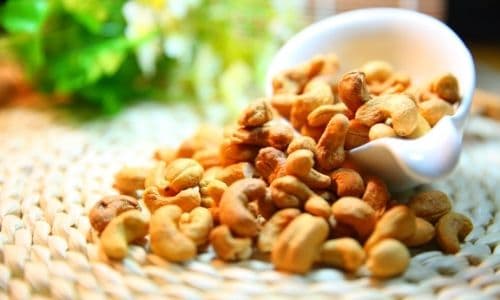
Low in sugar and rich in heart-healthy fiber, plant protein, and unsaturated fats, cashews deserve a spot in anyone’s diet.
You can eat cashews:
- Raw
- Roasted
Some vegans even use cashews to make vegan cheese with a little nutritional yeast for a butyric (cheesy) flavor.
Here’s the nutrition info for raw cashews.
Cashews
| Serving: 1 oz Calories: 157 |
||
|---|---|---|
| % Daily Value | ||
| Total Fat | 12g | 19% |
| Cholesterol | 0mg | 0% |
| Sodium | 3mg | 0% |
| Total Carbohydrates | 8g | 3% |
| Sugars | 2g | |
| Protein | 5g | 10% |
Cashews contain 11% of the daily value of iron, which is not bad for a handful of nuts.
And, according to research published in the International Journal of Applied and Basic Nutritional Sciences, inclusion of nuts in a typical diet does not induce weight gain, despite an increase to caloric intake.
That’s exactly what you want to hear because it means cashews are helping you supply your body with necessary macronutrients (like unsaturated fats) without causing you to gain weight.
Cashews are widely used in vegan and vegetarian cuisines, but there’s nothing more old-fashioned than snacking on a few cashews from the nut mix left over from a holiday get-together.
I won’t judge.
9. Almonds
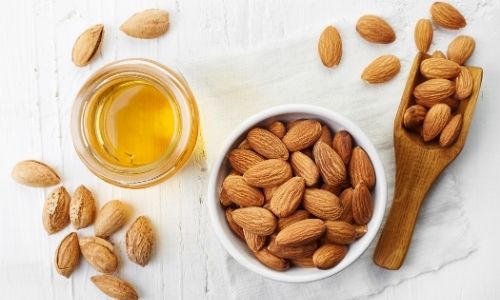
If you’re a Francophile or just a French cuisine snob like I am, you’ll recognize almonds from being the slivered nut served alongside some buttered haricot verts, or fancy-schmancy green beans.
While I’ll admit butter isn’t the best for you, toasted slivered almonds can really elevate a lot of vegetarian dishes.
Besides slivered, almonds can come:
- Raw (with skin)
- Raw (without skin)
- Toasted
Here’s the nutrition info for whole almonds.
Almonds
| Serving: 22 each Calories: 152 |
||
|---|---|---|
| % Daily Value | ||
| Total Fat | 13g | 20% |
| Cholesterol | 0mg | 0% |
| Sodium | 0mg | 0% |
| Total Carbohydrates | 6g | 2% |
| Sugars | 1g | |
| Protein | 6g | 11% |
Almonds also contain 13% of the daily source of fiber, which is great.
If you’ve ever drunk sherry before, you’ll recognize the flavor of almonds. Sherry, oddly enough, has hints of blanched almonds in its flavor profile (even though no nuts are used at all to produce it).
Additionally, research published in the Journal of Agricultural and Food Chemistry suggests that almonds can have a positive effect on modifiable cardiovascular and diabetes risks, such as:
- Body weight
- Glucose regulation
- Oxidative stress
- Inflammation
With all these health benefits, it’s no wonder the French love their almonds.
You should, too.
3 Grains That Go Straight to Your Bum
As mentioned earlier, carbohydrates are NOT the enemy.
By consuming healthy grains, you’re skipping past all the unhealthy carbs like processed white bread and twice-fried French fries and sticking to what will give you a thicker booty.
Research published in Nutrition Review suggests there’s strong evidence that a diet high in whole grains is associated with:
- Lower body mass index (BMI)
- Smaller waist circumference
- Reduced risk of being overweight
The study also says there is weak evidence that women who consume a high intake of refined grains will see an increase in waist circumference.
That’s good news because it means you can consume the right kind of grains without fear you’ll put on weight in the wrong area.
Of course, all this in moderation and balance.
These three grains are foods that go straight to your bum:
- Brown Rice
- Quinoa
- Whole Wheat Pasta
Let’s dive a little deeper!
10. Brown Rice
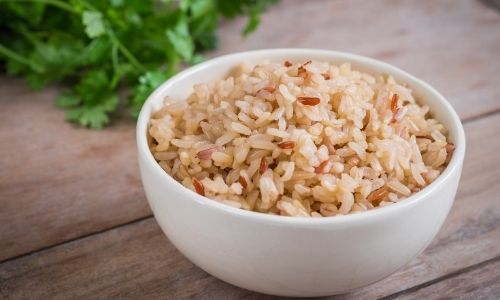
Brown rice is quite easy to incorporate into your diet.
You’ll see it:
- Steamed
- Fried
- Boiled
- Sautéed
Here’s the nutrition info for the long-grain version of brown rice (before being cooked).
Brown Rice
| Serving: 1/4 cup Calories: 171 |
||
|---|---|---|
| % Daily Value | ||
| Total Fat | 1g | 2% |
| Cholesterol | 0mg | 0% |
| Sodium | 3mg | 0% |
| Total Carbohydrates | 36g | 12% |
| Sugars | 0g | |
| Protein | 4g | 7% |
Depending on what you cook it with, the total number of calories might be altered, so don’t forget to factor that in.
But, brown rice is great for containing healthy carbohydrates without having any sugar on top of it.
Weight-Friendly Tip
One quick change you can make in your diet today is to begin ordering brown rice instead of white rice at any Asian restaurant. Most places won’t even charge you an extra fee.A lot of people operate under the misconception that rice can cause you to be fat, but rice is used as a staple food in many different cuisines, including:
- Chinese
- Korean
- Japanese
- Thai
- Indian
- Latin
Research published in the International Food Research Journal suggests that rice bran consists of polysaccharides (the form in which most carbs naturally occur) and dietary fiber that support cancer and cardiovascular diet therapy.
In other words, brown rice is heart-healthy.
Don’t shy away from brown rice just because you’re used to eating white rice. Give it a chance. You might just surprise yourself.
11. Quinoa

As I already mentioned, quinoa is one of the very few plant-based products to contain all the essential amino acids needed to be a complete protein source.
By default, that should make quinoa a staple part of your diet.
Here’s the nutrition info for dry quinoa.
Quinoa
| Serving: 1/4 cup Calories: 156 |
||
|---|---|---|
| % Daily Value | ||
| Total Fat | 3g | 4% |
| Cholesterol | 0mg | 0% |
| Sodium | 2mg | 0% |
| Total Carbohydrates | 27g | 9% |
| Sugars | 0g | |
| Protein | 6g | 12% |
In addition to being a great protein source, quinoa contains 12% of the daily value of fiber.
Believe it or not, despite being a grain, quinoa has more protein that fat or carbs.
It’s a carb without being a carb. That’s a win-win situation.
Research published in the Journal of Cereal Science suggests that quinoa has considerably positive effects on:
- Metabolic health
- Gastrointestinal health
- Cardiovascular health
But get this…
Besides its somewhat high import cost, the only reason it’s not widely consumed is because PEOPLE DON’T KNOW HOW FRICKIN’ GOOD QUINOA IS FOR YOU.
I’d like to change that.
Quinoa goes great in:
- Salads
- Soups
- Just by itself with herbs and seasonings
I’ve even made chocolate truffles using simply cooked quinoa as a thickening agent. You can’t even taste it but you get the satisfaction of knowing you’re eating the right thing.
If you’re not eating quinoa already, do it. Your plump butt will thank you later.
12. Whole Wheat Pasta

There are plenty of different kinds of whole-wheat pastas, including:
- Spaghetti
- Rotini
- Penne
- Lasagna
- Shells
- Macaroni
And the list goes on and on.
You could even make whole wheat pasta at home if you really wanted to.
Some commercial pasta companies don’t even use eggs in whole-wheat pastas to increase the shelf life, so there’s a strong chance your homemade pasta will taste 10 times better.
Mine typically does.
Here’s the nutrition info for whole-wheat spaghetti.
Whole Wheat Pasta
| Serving: 2 oz Calories: 198 |
||
|---|---|---|
| % Daily Value | ||
| Total Fat | 1g | 1% |
| Cholesterol | 0mg | 0% |
| Sodium | 5mg | 0% |
| Total Carbohydrates | 43g | 14% |
| Sugars | 0g | |
| Protein | 8g | 17% |
Whole-wheat pasta contains:
- 27% fiber (of the daily value)
- 11% iron (of the daily value)
That’s because according to the Journal of Food Chemistry, whole grains contain more vitamins, minerals, natural antioxidants, and dietary fiber than regular, refined grain products.
Weight-Friendly Tip
Pasta is one of the foods that people always overconsume. The serving size for this kind of pasta is just 2 ounces, or 1/4 cup, and just that contains 14% of the carbohydrates you should be consuming in a day.Instead of overdosing on pasta, consider surrounding a smaller serving of pasta with nutritious toppings, like:
- Vegetables
- Herbs
- Nuts
- Meat
Pasta is one of those foods that can be a real deal-breaker when it comes to sticking to a diet. I’m not telling you to avoid it.
Consume it in moderation, like everything else on this list and you’ll be just fine.
5 Vegetables That Will Make Your Butt Thick
Ever since you were a kid, you were probably told to eat your vegetables.
That was sound advice, but you may not have known it then. I’m here to remind you that it still is.
Research published in the Journal of the American Dietetic Association says that low-energy dense diets are associated with:
- Better diet quality
- Lower energy intakes (calories)
- Feeling full without eating too much
- Body weight management
Let’s break down what a low-energy dense diet is…
Low-energy refers to there being fewer calories in the food items. And, dense refers to there being a lot of those foods present in the diet.
Vegetables are low-energy, which is why they should comprise a large portion of your diet.
These 5 vegetables will help make your butt thicker:
- Avocado
- Black Beans
- Spinach
- Kale
- Chickpeas
Let’s dive a little deeper!
13. Avocado

If you’ve ever eaten guacamole, then you’ll know avocados are almost buttery in their texture and work really well mashed up.
Botanically speaking, avocados are berries because of the seed/pit inside them. But, that’s a conversation for another day.
Avocados are typically consumed raw as it can be quite challenging to cook an avocado on the stove.
Here’s the nutrition info for avocados.
Avocado
| Serving: 1 each Calories: 322 |
||
|---|---|---|
| % Daily Value | ||
| Total Fat | 29g | 45% |
| Cholesterol | 0mg | 0% |
| Sodium | 14mg | 1% |
| Total Carbohydrates | 17g | 6% |
| Sugars | 1g | |
| Protein | 4g | 8% |
Besides the high concentration of monounsaturated fat, avocados also contain:
- 54% fiber (of the daily value)
- 34% Vitamin C (of the daily value)
That’s for one whole avocado, though. If you eat half an avocado or less, then those numbers will go down.
Research published in Critical Reviews of Food Science and Nutrition suggests that the fatty acids found in avocados help to:
- Promote healthy blood lipid profiles
- Enhance the bioavailability of fat-soluble vitamins and phytochemicals
There are even preliminary studies that suggest avocado consumption can support cardiovascular health and exploratory studies suggesting avocados may support weight management and anti-aging.
You can eat avocados in:
- Salads
- Salad dressings
- Soups
- Sauces (like avocado mac ‘n cheese)
- Desserts
There are many innovative recipes you can try out with avocados.
Just watch your fat consumption on days when you eat avocados so you don’t end up clogging your arteries with fat instead of your bum.
14. Black Beans
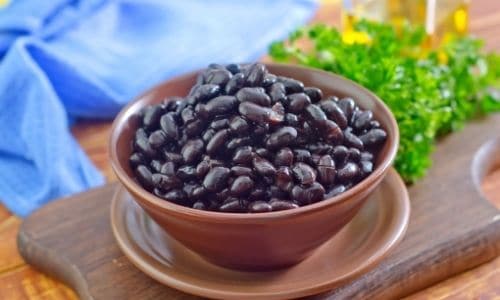
Black beans are one of the staple foods in Mexican and Latin cuisines. Refried beans are typically made of frijoles negros, or black beans.
While you can absolutely cook and boil your own beans, it’s probably to just use them out of a can.
Be sure to buy cans with reduced sodium and then thoroughly rinse off the liquid the beans are packed in so you’re left with just the nutrition of the beans.
Here’s the nutrition info for black beans.
Black Beans
| Serving: 1/2 cup Calories: 114 |
||
|---|---|---|
| % Daily Value | ||
| Total Fat | 0g | 0% |
| Cholesterol | 0mg | 0% |
| Sodium | 0mg | 0% |
| Total Carbohydrates | 20g | 7% |
| Sugars | 0g | |
| Protein | 8g | 15% |
Black beans also contain:
- 30% fiber (of the daily value)
- 10% iron (of the daily value)
Research published in The American Journal of Clinical Nutrition says that diets that include beans:
- Reduce low-density lipoprotein (LDL) cholesterol
- Favorably affect risk factors for metabolic syndrome
- Reduce the risk of ischemic heart disease and diabetes
And, beans are one of the only plant foods that provide significant amounts of the indispensable amino acid lysine.
Because black beans are rich in fiber and resistant starch, they don’t have a high glycemic index, which means they won’t negatively affect blood glucose levels.
That’s great news for diabetics or anyone who needs to watch their sugar levels.
Simply put, black beans are a staple food in many cuisines for a reason: they’re healthy.
15. Spinach

Spinach is one of my favorite veggies!
With very few calories per serving, you can eat as much as you want without feeling bad about it. It’s also 91% water, so it’s quite hydrating.
Here’s the nutrition info for spinach.
Spinach
| Serving: 1 cup Calories: 7 |
||
|---|---|---|
| % Daily Value | ||
| Total Fat | 0g | 0% |
| Cholesterol | 0mg | 0% |
| Sodium | 24mg | 1% |
| Total Carbohydrates | 1g | 0% |
| Sugars | 0g | |
| Protein | 1g | 2% |
Spinach is also vitamin rich, containing:
- 56% Vitamin A (of the daily value)
- 14% Vitamin C (of the daily value)
According to research published in The Journal of Agricultural and Food Chemistry, spinach leaves are a rich source of natural antioxidants.
Spinach can be prepared in many ways, including:
- Salad
- Pasta
- Smoothies
- Juices
- Sauces
It’s a very versatile ingredient.
And, it’s the favorite food of a certain sailor named Popeye. Maybe it’ll become yours, too.
16. Kale

Believe it or not, kale is a kind of cabbage.
And, within kale, there are many varieties including:
- Curly kale (the common one)
- Dinosaur kale
- Baby kale
Like a lot of leafy greens (in the cabbage family) there is a protruding rib that you’ll probably want to trim down or remove altogether before eating.
But, it is edible in case you want to add kale to your smoothie or juice it.
Here’s the nutrition info for fresh kale.
Kale
| Serving: 1 cup Calories: 34 |
||
|---|---|---|
| % Daily Value | ||
| Total Fat | 0g | 1% |
| Cholesterol | 0mg | 0% |
| Sodium | 29mg | 1% |
| Total Carbohydrates | 7g | 2% |
| Sugars | 0g | |
| Protein | 2g | 4% |
Fresh kale contains:
- 206% Vitamin A (of the daily value)
- 134% Vitamin C (of the daily value)
A nutrient-dense food, kale has little fat and carbohydrates, but a small amount of protein.
It’s more known for being a superfood, though, which hasn’t exactly been vetted by scientists.
Few studies have been performed on kale to know the full nutritional and biological benefit it provides.
However, according to the scientific journal Nutrients, recent studies suggest that foods rich in prebiotic carbohydrates and dietary fiber can potentially reduce the risk of non-communicable diseases, such as:
- Obesity
- Cancer
- Heart disease
- Diabetes
The next time you buy produce at the supermarket, consider kale. It’s a healthy vegetable with culinary versatility.
And, it will fill you up so you don’t gain the wrong kind of fat in your buttocks.
17. Chickpeas
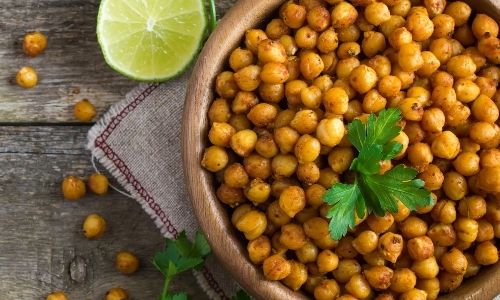
Also known as garbanzo beans, chickpeas are the main ingredient of the Middle-Eastern dish hummus. Add to it tahini, garlic, some olive oil, and herbs, and you’ve got an easy condiment that’s healthy for you.
Chickpeas can be found:
- Raw
- Canned
It’ll probably be easier (and time-efficient) if you buy canned garbanzo beans.
Here’s the nutrition info for chickpeas.
Chickpeas
| Serving: 1/2 cup Calories: 106 |
||
|---|---|---|
| % Daily Value | ||
| Total Fat | 2g | 4% |
| Cholesterol | 0mg | 0% |
| Sodium | 334mg | 14% |
| Total Carbohydrates | 16g | 5% |
| Sugars | 0g | |
| Protein | 6g | 12% |
Chickpeas are technically classified as pulses, which are the edible seed from a legume plant.
They also contain 21% of the daily value of fiber.
Weight-Friendly Tip
After you drain a can of chickpeas, don’t throw the liquid out. The cooking liquid for beans like chickpeas is called aquafaba and it’s a common ingredient in vegan cuisine. It whips up just like egg whites and is an alternative for people who can’t eat eggs. It also has fewer calories.Research published in the British Journal of Nutrition suggests that chickpeas, in combination with other pulses and cereal grains, can have beneficial effects on diseases, such as:
- Cardiovascular disease
- Type 2 diabetes
- Digestive diseases
- Some cancers
Even though lipids (fats) are present in low amounts, chickpeas are a good source of unsaturated fatty acids such as linoleic and oleic acids.
Whether you puree chickpeas, use them in salads, or just fry them in a little oil for crunch, they’re a great addition to your diet.
Chickpeas contain enough fat to help your butt get thicker without causing you to gain weight in other areas.
4 Dairy Foods That Go Straight to Your Bum
Since the 1980s, the dietary guidelines for Americans have promoted low- or fat-free dairy foods.
And, I’m not opposed to eliminating it altogether if there’s a better option.
After all, what other species consumes a different one’s milk? Kind of weird when you think of it that way.
Anyway, research published in the internationally reviewed journal Advances in Nutrition suggests that the consumption of full-fat dairy foods has a neutral or inverse reaction association with adverse cardiometabolic outcomes, including:
- Atherosclerotic cardiovascular disease
- Type 2 diabetes
So, the takeaway is that if you’re going to consume dairy products, you should do the less-fat versions when possible.
Here are 4 dairy products that will make your butt thicker (a full-fat kind of situation):
- Milk
- Greek Yogurt
- Cottage Cheese
- Protein Shake
Let’s dive a little deeper!
18. Milk

When you shop for milk, you’ll find the following types:
- Whole milk (3.25% milk fat)
- Reduced-fat milk (2% milk fat)
- Low-fat milk (1% milk fat)
- Fat-free or skim milk (0% milk fat)
There are also many different kinds of milk.
Cows aren’t the only mammal whose milk we drink.
Others include:
- Sheep
- Goat
- Buffalo
- Camel
- Llama
- Yak
- Deer
You’ll find some of those in cheeses, but you can drink them.
Unless you’re an expert in raw milk, stay away and stick to pasteurized milk.
Here’s the nutrition info for 2% milk.
Milk
| Serving: 1 cup Calories: 122 |
||
|---|---|---|
| % Daily Value | ||
| Total Fat | 5g | 7% |
| Cholesterol | 20mg | 7% |
| Sodium | 115mg | 5% |
| Total Carbohydrates | 12g | 4% |
| Sugars | 12g | |
| Protein | 8g | 16% |
Milk also contains 29% of the daily value of calcium, which is why it is recommended for kids to consume. Calcium is associated with bone strength and density.
Research published in Nutrients suggests that milk lipids may beneficially influence:
- Dysfunctional lipid metabolism
- Gut dysbiosis
- Inflammation
- Cardiovascular disease
- Gut health
- Neurodevelopment
I personally don’t drink milk straight, although I used to love chocolate milk as a kid. The recipe for that was a little bit of milk and a lot of chocolate syrup.
Not the healthiest…
These days, I use milk a lot in sauces for pasta. Milk forms the base of the French béchamel sauce, which is used to make mac ‘n cheese, the traditional way that is.
As long as you’re careful on how much fat you consume through milk, it can be a great food to comprise your fat intake.
19. Greek Yogurt
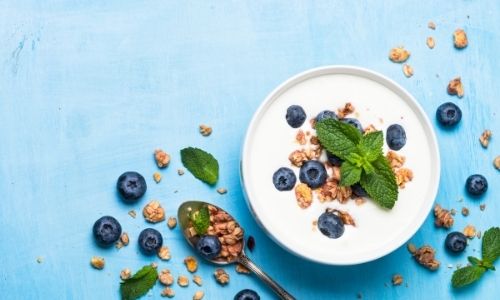
Yogurt, or yoghurt in the UK, is a dairy food made from cultured and fermented milk.
What separates Greek yogurt from regular yogurt is the process through which it’s made.
Essentially, you take regular, old-fashioned yogurt and place it in fine-mesh cloth (or cheesecloth) and allow the liquid to drain. That liquid is known as whey.
What’s left is Greek yogurt, which is thicker and contains less moisture than regular yogurt. It’s like a purified version, which is why it’s widely considered to be healthier.
Here’s the nutrition info for Greek yogurt.
Greek Yogurt
| Serving: 1 cup Calories: 300 |
||
|---|---|---|
| % Daily Value | ||
| Total Fat | 23g | 35% |
| Cholesterol | 40mg | 13% |
| Sodium | 65mg | 3% |
| Total Carbohydrates | 7g | 2% |
| Sugars | 7g | |
| Protein | 15g | 30% |
Like milk, it does contain a moderate amount of calcium, or about 20% of the daily value.
You’ll notice that just one cup of Greek yogurt contains just around 1/3 of the total fat you should be consuming in one day.
You can find reduced-fat versions of Greek yogurt if you’d like to limit that amount. But, they are a great protein source as is.
According to research published in the International Journal of Scientific & Research Publications, yogurt is reported to claim:
- Improved lactose intolerance
- Immune enhancement
- Prevention of gastrointestinal disorders
Because yogurt contains probiotics, it’s great for your gut and stomach health.
Greek yogurt can be used in recipes for:
- Smoothies
- Soups (as a garnish)
- Desserts
You can also simply eat it for breakfast with berries and nuts, as pictured above.
If you don’t consume any other food high in probiotics (or take a supplement), consider trying out Greek yogurt as a a healthy source of fat and protein.
20. Cottage Cheese
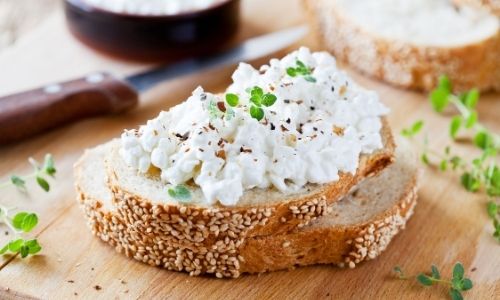
Cottage cheese is one of those foods that A LOT of people cringe at when they hear its name.
Myself, included.
But, cottage cheese can be really healthy for you.
It’s an acidulated cheese, which means that rather than using rennet or thistle to form curds, acid is used.
Other cheeses like that are:
- Paneer
- Ricotta
- Queso blanco
- Quark
Here’s the nutrition info for cottage cheese.
Cottage Cheese
| Serving: 1 cup Calories: 97 |
||
|---|---|---|
| % Daily Value | ||
| Total Fat | 3g | 4% |
| Cholesterol | 11mg | 4% |
| Sodium | 373mg | 16% |
| Total Carbohydrates | 4g | 1% |
| Sugars | 4g | |
| Protein | 13g | 27% |
Although cottage cheese only contains 10% of the daily value of calcium, it’s a protein powerhouse and contains little fat and carbohydrates.
It does have a higher sodium content, which is an unfortunate byproduct of processing.
A recent study published in the British Journal of Nutrition suggests that consuming 30 grams of a whole-food protein such as cottage cheese about 30 minutes for bed appears to positively affect:
- Muscle quality
- Metabolism
- Overall health
If you’re not sure how to incorporate cottage cheese into your diet, consider spreading it on toast like the picture above or mixing it with elbow pasta.
No need for a complicated recipe.
If you’ve been hesitant to try cottage cheese, take the plunge! You may regret it, but I promise it’s healthy.
21. Protein Shakes
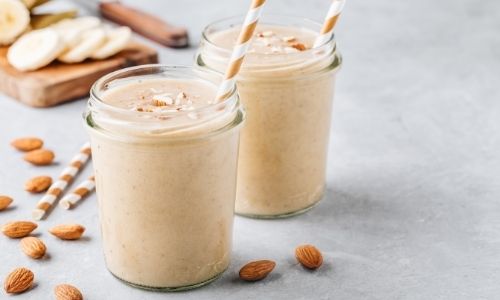
Protein shakes come in many different:
- Flavors (such as chocolate, vanilla, strawberry, unflavored)
- Compositions (dairy, vegan)
- Sizes (how much a serving is based on how concentrated the powder is)
This is why it’s hard to present nutritional info for protein shakes. Here’s the info for Pro Science FINISH vanilla protein powder.
Protein Shakes
| Serving: 1 package Calories: 290 |
||
|---|---|---|
| % Daily Value | ||
| Total Fat | 5g | 8% |
| Cholesterol | 50mg | 17% |
| Sodium | 270mg | 11% |
| Total Carbohydrates | 25g | 8% |
| Sugars | 5g | |
| Protein | 35g | 70% |
The good news is that protein powders always list nutrition info on their labels, so you can consult them when planning out your daily calories.
Protein powders are usually fortified with vitamins and minerals.
This one in particular contains:
- 12% fiber (of the daily value)
- 35% Vitamin A (of the daily value)
- 50% Vitamin C (of the daily value)
- 60% calcium (of the daily value)
- 50% iron (of the daily value)
As you can see, it’s fortified quite a bit.
According to research published in the official journal of the American Academy of Pediatrics, 4.7% of boys and 1.6% of girls surveyed used protein powder or shakes weekly to improve appearance or strength.
Weight-Friendly Tip
Protein powders are deceptive. At face value, they appear to be laden with nutrients and protein. But, they shouldn’t be used as a substitute for proper nutrition. They are a supplement and are often misused in high quantities to build muscle, gain weight, and improve definition. Use with discretion.Before picking out a protein powder, make sure you read reviews and usage instructions. If your goal isn’t to build muscle, then you can likely avoid protein powders.
But, in small quantities, they can be a great nutritional supplement for an extra boost before or after a workout (you don’t get a big butt just by eating).
4 Meats That Make Your Butt Juicy
I’ll be the first to admit that meat products have been scientifically linked to diseases, such as heart disease and diabetes.
But, if you follow diets like the Mediterranean diet for example, you’ll know that meat shouldn’t be consumed too frequently.
And, if you’re an average American, then you likely consume meat in massive portions, which is how you end up with said diseases above.
Research published in Public Health Nutrition says that plant-based dietary patterns which include small intakes of red meat, fish, and dairy products have demonstrated significant improvements in overall health status.
So, it’s our conclusion that consuming meat-based products in small quantities isn’t terrible for your health.
These meat and animal-based products will help shape your booty:
- Chicken Breast
- Eggs
- Turkey Breast
- Ground Pork
Let’s dive a little deeper!
22. Chicken Breast
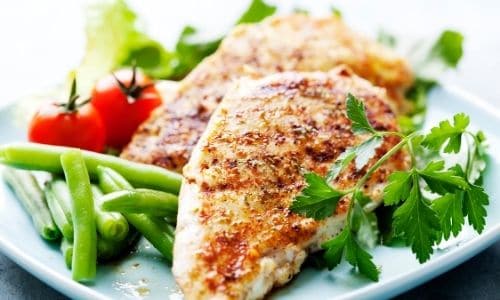
Chicken is a leaner meat. The dark meat (thighs, legs) contains more fat than the white meat (breast).
If you’re going to consume chicken, I recommend the breast.
Here’s the nutrition info for raw chicken breast with the skin.
Chicken Breast
| Serving: 1 each Calories: 249 |
||
|---|---|---|
| % Daily Value | ||
| Total Fat | 13g | 19% |
| Cholesterol | 93mg | 31% |
| Sodium | 910mg | 4% |
| Total Carbohydrates | 0g | 0% |
| Sugars | 0g | |
| Protein | 30g | 60% |
It’s totally up to you if you want to remove the skin from the breast. If you do, you’ll end up with less fat than the table above represents.
Even without the skin, chicken is still a significant source of cholesterol.
But, it also contains a massive amount of protein, which is the whole point of including it on this list.
Research published in Nutrition suggests that a diet that promotes increased fiber and lean protein resulted in calorie and weight reductions.
That’s good news because chicken breast can be used to supply a lot of protein naturally without forcing weight gain in unwanted areas.
Healthy ways to prepare chicken include:
- Boiled
- Baked
- Grilled
- Broiled
- Steamed
Avoid heavy cream sauces or anything that takes away from the core nutritional value of the chicken breast.
And, don’t rely on chicken as a protein crutch.
There are plenty of other protein sources that you can eat that are just as healthy if not healthier for your overall figure.
23. Eggs

Don’t hate me because I put eggs in the section of meats.
They are an animal-based product and belong in this section, even if lacto-ovo vegetarians don’t consider eggs to be meat.
Here’s the nutrition info for eggs.
Eggs
| Serving: 1 each Calories: 72 |
||
|---|---|---|
| % Daily Value | ||
| Total Fat | 5g | 7% |
| Cholesterol | 186mg | 62% |
| Sodium | 71mg | 3% |
| Total Carbohydrates | 0g | 0% |
| Sugars | 0g | |
| Protein | 6g | 13% |
Just one egg is over 60% of your daily serving of cholesterol, which is massive. If you have cholesterol issues, you should avoid eggs when possible, particularly the yolks.
Egg yolks contain high amounts of cholesterol while the whites contain the protein, presented as albumin.
It’s perfectly acceptable to make an omelette out of egg whites if you want to ditch the yolks altogether. But, if you want to indulge in an egg yolk every now and then, I won’t judge.
Research published in the Journal of Agricultural and Food Chemistry says that various biological activities have been associated with egg components, including:
- Antimicrobial activities
- Antiadhesive properties
- Immunomodulatory, anticancer, and antihypertensive activities
- Antioxidant properties
- Protease inhibitors
- Nutrient bioavailability
- Functional lipids
Continued research on eggs helps explain how they can be used to prevent chronic and infectious diseases.
If none of the above makes sense to you, then understand that eggs are multi-faceted and assist in many functions beneficial to your body.
There are many ways to eat eggs, including:
- Boiled (soft, medium, and hard)
- Fried
- Omelette
- Scrambled
- Coddled (or shirred)
- Deviled
However you consume your eggs, be conscious of the cholesterol content.
But, don’t let that stop you from eating eggs on a regular basis as their protein content packs a punch for the serving.
24. Turkey Breast
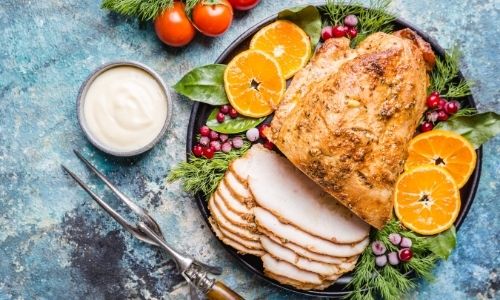
If you’ve overdosed on turkey during Thanksgiving before and passed out, then you’ve likely experienced the effects of tryptophan, the essential amino acid found in turkey that can make you sleepy.
Whether as a sliced deli meat or baked whole, turkey can be a great addition to your diet.
Like chicken, turkey breast is a lean meat.
Here’s the nutrition info for raw turkey breast with the skin.
Turkey Breast
| Serving: 4 oz Calories: 178 |
||
|---|---|---|
| % Daily Value | ||
| Total Fat | 8g | 12% |
| Cholesterol | 74mg | 25% |
| Sodium | 67mg | 3% |
| Total Carbohydrates | 0g | 0% |
| Sugars | 0g | |
| Protein | 25g | 50% |
Like chicken, you’ll note that turkey has a massive amount of protein for one serving. And, if you remove the skin, then you’ll get rid of some of the fat content in the table above.
Just remember that one serving is not an actual whole turkey breast.
This isn’t the renaissance fair, but rather, a balanced diet.
Remember tryptophan? Research published in Amino Acids, the forum for amino acid, peptide, and protein research says that tryptophan is the precursor for serotonin.
Serotonin is the key hormone that stabilizes:
- Mood
- Feelings of well-being
- Happiness
So, consuming turkey breast isn’t such a bad idea.
But, don’t do it too frequently or in large quantities or your butt will be the thing stuffed to the brim at Thanksgiving next year.
25. Ground Pork

Pork is that fatty meat so presently found in sausages, meatballs, hamburgers, and the world of forcemeat.
Back in my garde manger class in culinary school, we used to work with ground pork quite a bit.
Ground pork is prized because of its higher fat content, which adds juiciness so the meat isn’t dry.
Here’s the nutrition info for raw ground pork.
Ground Pork
| Serving: 4 oz Calories: 298 |
||
|---|---|---|
| % Daily Value | ||
| Total Fat | 24g | 37% |
| Cholesterol | 82mg | 27% |
| Sodium | 64mg | 3% |
| Total Carbohydrates | 0g | 0% |
| Sugars | 0g | |
| Protein | 19g | 38% |
The reason pork is included on this list is because of its protein content.
Unlike some of the other foods on this booty-shaping list, the fat in pork is saturated and not the best for you. Just 4 ounces of ground pork is 37% of your total fat recommendation for the day, which is quite alarming.
It also contains a significant amount of cholesterol.
But, ground pork isn’t all that bad.
Weight-Friendly Tip
While the saturated fat content is high, it used to be higher. Today’s pork contains about 16% less fat and 27% less saturated fat than it did 30 years ago. Just because there is a trend in decreasing fat contents in pork doesn’t mean that you can’t substitute pork products for vegetarian or vegan counterparts, such as Beyond Meat.Research performed by scientists at the University of South Australia used 144 overweight adults who were told to consume 1 kilogram of pork per week by substituting for other foods (mainly beef and chicken) in their normal diet.
In comparison to the control group, there were significant reductions in:
- Weight
- Body mass index (BMI)
- Waist circumference
- Body fat percentage
- Fat mass
- Abdominal fat
So, the conclusion here is that regular consumption of lean fresh pork may improve body composition.
But, once the pork is processed and turned into barely recognizable products, the nutritional value is gone.
2 Vegan Foods That will Make Your Butt Big
I hate the rumor going around that ALL vegan food tastes terrible.
It’s just subjective and frankly speaking, uninformed.
Vegan food can be a great way to supplement your diet with welcomed plant alternatives that are nutritionally dense.
Here’s an interesting tidbit of information about the vegan diet you probably didn’t know.
Research published in The American Journal of Clinical Nutrition suggests that a low-fat vegan diet performed better against a traditional “diabetes” diet in improving glycemia and plasma lipids.
In my opinion, if vegan diets can be used to treat diseases, then they’re worth following (at least in part).
These two vegan foods will go straight to your bum:
- Tofu
- Soy Milk
Let’s dive a little deeper!
26. Tofu
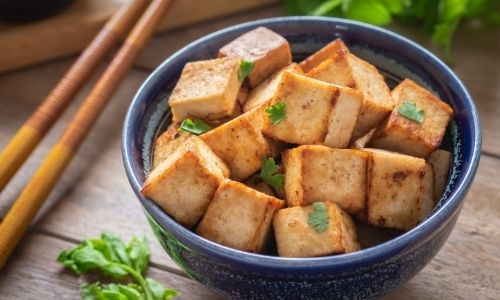
Tofu, also known as bean curd, is one of the soy-based foods that can easily be bland if you don’t season it properly.
Tofu comes in the following varieties (from least to most firm):
- Silken
- Soft
- Medium
- Firm
- Extra-firm
- Super firm
The firmer tofu is, the less moisture and water content is present.
Less water makes tofu excellent for sautéing because it holds its shape better.
Here’s the nutrition info for tofu.
Tofu
| Serving: 1 package Calories: 63 |
||
|---|---|---|
| % Daily Value | ||
| Total Fat | 3g | 4% |
| Cholesterol | 0mg | 0% |
| Sodium | 3mg | 0% |
| Total Carbohydrates | 2g | 1% |
| Sugars | 0g | |
| Protein | 7g | 14% |
As mentioned before, soy is one of the few plant proteins that contains all the essential amino acids. So, the protein present in tofu is a complete source.
Tofu also contains 20% of the daily value of calcium, which is a great alternative if you don’t want to consume daily products.
Research published in Food & Beverages Processing says that eating soy-based products can help prevent:
- Breast cancer
- Osteoporosis
- Cardiovascular disease
Soy is a unique in that it contains a high concentration of isoflavones, which are a type of plant estrogen similar in function to human estrogen but with weaker effects.
Some women have states that soy helps them control their hot flashes.
Weight-Friendly Tip
It was at one point thought that tofu (soy, really) was associated with a higher risk of cancer, particularly breast cancer. That belief has since been disproven, and tofu can be regularly consumed by both men and women.Tofu is a staple in Asian cuisine and is easy to swap out for another protein like chicken or beef in your takeout.
It’s also tasty in salads.
Don’t be afraid to heavily flavor tofu so you get its health benefits while enjoying its flavor. I promise it’s healthy for you and your bum.
27. Soy Milk
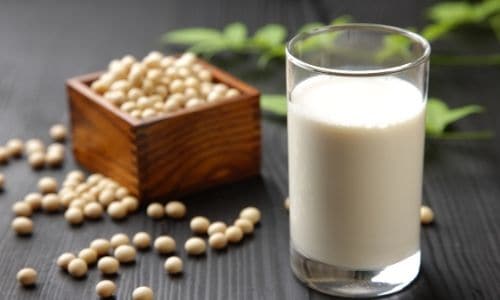
Soy milk is a great alternative to animal milk.
Sometimes, it’s fortified with vitamins and minerals, just like regular milk is.
One of the main benefits of soy milk as opposed to animal milk is that it’s commercially sold with lower fat AND sugar contents.
Producers have taken great care to ensure that animal milk “tastes good” by adding sugar where it doesn’t belong.
When you buy soy milk, make sure to choose the unsweetened variety. You can always add a plant-based sweetener, honey, or agave to sweeten it if you need.
Here’s the nutrition info for plain Silk soy milk.
Soy Milk
| Serving: 1 cup Calories: 100 |
||
|---|---|---|
| % Daily Value | ||
| Total Fat | 4g | 6% |
| Cholesterol | 0mg | 0% |
| Sodium | 120mg | 5% |
| Total Carbohydrates | 8g | 3% |
| Sugars | 6g | |
| Protein | 7g | 14% |
Soy milk is also a good source of vitamins, containing:
- 10% Vitamin A (of the daily value)
- 30% Vitamin C (of the daily value)
Research published in The Journal of Nutrition suggests that soy milk can be used to help treat hypertension.
Chronic soy milk consumption was linked to a modest, but significant reduction in blood pressure, which is another benefit of the vegan superfood soy.
Soy milk goes great in:
- Coffee
- Smoothies
- Cereal
It can practically be substituted for animal milk in every usage, but soy milk is much healthier.
If you can’t fathom the idea of eating tofu and would rather substitute it for soy milk, that’s a great step in adopting a more plant-based diet.
Besides, soy milk and cow milk are comparable in protein numbers, so there’s no excuse for a little substitution here and there.
Conclusion
This massive, 8,000-word guide walked you through the various macronutrients and how they all help contribute to your overall health.
Then I went over the 27 foods that will go straight to your bum so you get healthy, thick curves.
Here they are again for reference:
- Salmon
- Tuna Fish
- Sardines
- Anchovies
- Flax Seeds
- Chia Seeds
- Pumpkin Seeds
- Cashews
- Almonds
- Brown Rice
- Quinoa
- Whole Wheat Pasta
- Avocado
- Black Beans
- Spinach
- Kale
- Chickpeas
- Milk
- Greek Yogurt
- Cottage Cheese
- Protein Shakes
- Chicken Breast
- Eggs
- Turkey Breast
- Ground Pork
- Tofu
- Soy Milk
If you have questions on how to incorporate these foods into your diet, drop them into the comments below.
I promise I’ll answer every question so you can achieve your dream figure.
To your weight-loss success!

